2 Research Methods in Psychology
Scientific Explanation
As mentioned previously, by explanation we usually mean a statement of cause and effect. Scientists refer to potential causes as independent variables and the related effects as dependent variables. Different sciences are defined by the dependent variables of interest. That is, physics studies the effects of different independent variables on matter and energy. Biology studies the effects of different independent variables on life processes. Psychology studies the effect of different independent variables on the behavior of individual animals.
All sciences assume that nature is lawful and that if you study nature systematically the underlying laws can become known. This assumption is referred to as determinism and is not today considered controversial with respect to physics, chemistry, and biology. We look to these disciplines to provide answers regarding questions regarding how nature works and benefit from technological advances resulting from scientific understanding. The assumption of determinism with regard to human behavior, however, is considered very controversial by those believing we possess freedom of the will. I hope to reduce or eliminate the controversy by pointing out that the logical opposite of determinism is not freedom of the will, but non-determinism. That is, the logical opposite of the assumption that nature is lawful is that nature is not lawful. Everyone, including those believing strongly in freedom of the will, acts as though behavior is lawful. We (usually) stop at red lights and proceed when they turn green. We (usually) take turns listening and speaking. We (usually) show up for class on time, etc., etc. None of this would be true if we did not expect others to act in a predictable manner. Predictability, implying lawfulness, can only be true within a deterministic system.
Let us now consider what psychology considers a lawful explanation of human behavior. We start with a couple of scenarios. Imagine that you are in a classroom and a person your age enters, walks over to a wall and starts banging their head against it. Then the person takes a seat and starts talking out loud to someone else, although no one else is present. Someone from the university counseling center enters the room and concludes these behaviors occur as the result of schizophrenia. Another person your age enters the classroom, congested and coughing. Someone from the university health services concludes the person is experiencing these symptoms as the result of influenza.
These two scenarios appear very similar. An individual’s behaviors or physical symptoms are explained by reference to an underlying condition or illness. However, the first example constitutes an example of a pseudo- (i.e., false) explanation whereas the second example could fulfill the requirements of an adequate explanation. Why is that? Both explanations involve terms that are difficult to pronounce and spell. What makes influenza “better” than schizophrenia? Remember, by explanation we mean a statement of cause and effect. This requires a separate observable potential cause (independent variable) and effect (dependent variable). In the case of influenza, a specific bacteria or virus can be detected through the appropriate tests. The term influenza does not simply stand for a syndrome of symptoms. It stands for the relationship between a specific “germ” and a specific syndrome. It is possible to test and replicate the relationship between this specific germ and specific symptoms. This is not the case with the term schizophrenia which is defined exclusively on the effect (dependent variable) side (DSM 5, 2013). It is circular to explain a phenomenon with the name for the phenomenon. Why does the person behave that way; because the person is schizophrenic. How do you know the person is schizophrenic; because the person behaves that way.
As will be shown repeatedly, pseudo-explanations can be extremely problematic in psychology. For example, it is known that students’ getting out of their seats can be increased through the attention of their teacher (Allen and Harris, 1966). If you were informed that your child gets out of the seat frequently because of attention deficit hyperactivity disorder (ADHD), you might not search for an alternate explanation. Even worse, there is the potential for the development of a self-fulfilling prophecy. That is, by virtue of being labeled ADHD, others might treat your child differently, resulting in the problem behaviors increasing in frequency. Earlier, I emphasized the importance of knowing when you know something and when you do not. The possibility of accepting a pseudo-explanation is an important example. One of the most valuable lessons you can learn is when you understand a phenomenon (in psychology or otherwise) and when you do not. Be vigilant for pseudo-explanations. Always look for testable relationships between observable independent and dependent variables.
Exercise
Nature/Nurture and Explanation
I am sure you are familiar with so-called nature-nurture controversies. For example, some suggest that heredity is more important than the environment or vice versa with respect to schizophrenia or intelligence. In technical journals, one will see reference to heritability ratios as indications of the extent to which behavior results from genetic influences. This is another controversy that I believe is best reframed, as we did with questions regarding freedom of the will. Let us combine some of the elements of the novels Jurassic Park (Crichton, 1990) and Tarzan of the Apes (Burroughs, 1914) to show how. Someone is exploring the sight where Marie Curie or Albert Einstein died and discovers a mosquito frozen in amber. It is determined that this mosquito stung the scientist while alive and it is possible to extract the DNA and clone it. A healthy, lively infant results and is given to a loving pair of gorillas to raise. Obviously, this infant’s genetic potential will never be realized in this impoverished environment (by current technologically advanced human standards). The reverse is also true. We could provide a wonderful, loving pair of human parents with a chimpanzee to raise. This, in fact, was done with the famous chimp Washoe, the hero of a wonderful book, Next of Kin (Fouts, 1997). I can guarantee you that this book will make you laugh and make you cry and that you will never think of chimpanzees in the same way. Chimpanzees share more than 98% of their DNA with humans (Pollard, 2009). Still, by human standards, Washoe does not attain many of the complex abilities that the great majority of us do as adults. That remaining 2% of DNA accounts for some very significant differences in our genetic potential.
Nature/nurture issues frequently arise in psychology. For example, to what extent is intelligence (see Chapter 7), personality (see Chapter 9), or abnormal behavior (see Chapter 11) influenced by each? Psychology studies the influences of genetics (nature) and experience (nurture) on every aspect of individual behavior. In the next section, the methods developed by psychologists to scientifically study the effects of different variables on behavior will be described.
Exercise
The Scientific Revolution
It is not coincidental that reliance upon empirical testing resulted in tremendous strides in physics, chemistry, and biology. Many of the technological advances we take for granted in our modern world (e.g., electricity, plastics, and inoculations against diseases) subsequently emerged. Figure 1.6 dramatically shows the transformation of New York City that took place over the course of the four centuries since Henry Hudson arrived there in 1609. The island was transformed from the forest it had been for hundreds of thousands of years to a modern metropolis. These spectacular feats of engineering and construction would never have been possible without the systematic application of the scientific method. The combination of science and practice has enabled us to develop powerful technologies capable of transforming our environment and way of life. Clearly, we must appreciate this powerful methodology if we are to understand our contemporary human condition.

Figure 1.6 How Manhattan Island appeared in 1609 when Henry Hudson landed there and in 2009
Scientific Questions
Not everything that can be counted counts, and not everything that counts can be counted
(Cameron, 1963)
Might a contemporary scientist be interested in determining the number of angels that could fit on the head of a pin? When I ask this question, students frequently chuckle, some seeming uncomfortable. When I ask, might a contemporary scientist be interested in determining the number of influenza viruses that could fit on the head of a pin, students usually respond “yes”, immediately recognizing the difference between the questions. Given the limitations of human senses and currently existing technologies, we are unable to observe the presence of angels and therefore to count them. However, thanks to the existence of electron microscopes we could theoretically count influenza viruses. The fact that electron microscopes did not exist until 1931 does not mean that influenza viruses did not exist or that they were not important. The scientific method is limited to questions that may be tested through empirical observation. Only then is there the possibility for replication of results, a requirement for scientific advancement. However, if the limitations of being observable, testable, and replicable are met, we know of no more reliable, powerful strategy for determining cause and effect in nature. Next, we will review the early history of psychology, considering the implications and challenges of applying the scientific method to the subject matter.
Video
Watch the following video to see examples of the scientific method:
Exercises
Describe the strengths and limitations of the scientific method in determining cause and effect in nature.
As mentioned previously, Psychological Statistics and Research Methods are the only two courses other than Introduction to Psychology taken by practically all psychology majors. This is because if psychology is to be considered a science interested in explaining some aspect of nature (the behavior of individual animals), all psychologists must be familiar with the strength and imitations of different procedures for studying behavior and arriving at explanations.
Internal and External Validity
It is almost universal on college campuses that the laboratory sciences occupy separate facilities from the humanities. Laboratories create isolation from many of the extraneous variables that might influence research results. They typically include extensive electrical and plumbing requirements beyond those of “chalk-and talk” classrooms. It is the emphasis upon control and precision that results in the laboratory sciences being described as “hard” in comparison to non-empirical disciplines. For example, if one were interested in replicating Galileo’s observations regarding the influence of the effect of weight on the rate at which an object falls, it is advantageous to perform the observations inside where the wind would not play a role. Laboratories also permit greater control of the independent variable and precision in the measurement of the dependent variable . Today we could create perfect spheres that differ only in weight and measure the time taken to fall any distance in millionths of a second. Despite the differences between the laboratory and external environments, we would expect the findings to continue to apply. In fact, this would constitute an empirical question that could be tested using the scientific method. Any time the findings did not apply would suggest further research to determine the cause(s). For example, fans of different sizes and power could be placed at different locations to systematically study wind effects.
Exercise
Non-experimental Research Methods
Experimentation, where the researcher is able to manipulate the independent variable and control for the influence of other possible confounding variables (i.e., other potential influences on the dependent variable), is the most reliable and powerful method for determining cause and effect. However, it is not always possible to conduct experiments in psychology (or other sciences, for that matter). Sometimes, you do not have the ability to manipulate a variable. For example, one cannot “make” someone male or female, or a particular age, etc. We can only select subjects already possessing the different attributes. We do not have the power to manipulate geographic or climatic variables to see the extent to which they influence behavior. Many variables cannot be manipulated for ethical reasons. For example, we cannot systematically punish children severely to see if that is an effective technique for eliminating undesirable behavior. Indeed, some have even questioned studying the effect of punishment on the dangerously self-destructive acts of autistic children (Bettelheim, 1985). For these reasons, many in the other laboratory sciences describe psychology as “soft.” Sometimes they even question the possibility of conducting psychology as a science. The research findings described in this book attest to the fruitfulness of applying the scientific method to psychological questions. The discipline of psychology frequently applies non-experimental designs under conditions where experimental procedures are logistically impossible, prohibitive in cost, or unethical.
Frequently non-experimental studies can provide information about the relationship between variables despite not being able to demonstrate cause and effect. However, even when relationships between variables are compelling, for example when a substantial statistical correlation exists, it is still not possible to conclude cause and effect. Often there is a hidden third variable underlying the correlation. For example, it is likely there is a high correlation between the number of books in one’s home and success in school. That does not mean that by simply providing books to an individual it will improve school performance. It is likely the number of books in one’s home is indicative of a number of economic and attitudinal advantages. Still, the fact that this correlation exists is informative and could lead to an experiment to test whether there is a cause and effect relationship between the number of books and school performance.
Exercise
Experimental Research Methods
Experimental procedures involve the systematic manipulation of an independent variable in such a way as to permit the demonstration of an effect on a dependent variable. Theoretically, in psychology this would involve manipulation of genetic and/or experiential independent variables to see the extent to which they influence individual behavior. In practice, due to current technological limitations with respect to “genetic engineering”, experimental psychological research practically always involves manipulation of experiential variables. Following up on the previous example, the number of books in a home would need to be systematically manipulated as described below.
Studies Comparing Groups
In psychology, group studies conforming to major statistical designs (e.g., t-tests, analysis of variance, etc.) are the most popular experimental procedures. Small-N (i.e., small number of subjects) designs are also popular and have their distinct advantages. Before describing them, we will review the rationale underlying group studies. As mentioned before, even animals of the same species (especially humans) differ from each other. The logic of group studies is that with sufficient sample sizes (i.e., the number of subjects in each group), random assignment to conditions (groups) should result in comparable averages for all subject characteristics. That is, if 200 children were randomly selected from the general school population and assigned to two conditions according to the flip of a coin, we would expect each condition to start out with approximately the same gender, racial, and ethnic composition, to be of the same average height, age, intelligence, etc. Therefore, if after manipulation of the independent variable (e.g., the number of books provided) the groups differed significantly in their academic performance, it would be possible to conclude that the number of books caused the difference rather than a subject characteristic.
The great majority of experimental research studies cited in this book are group designs. Often it is only necessary to include two groups to demonstrate an effect, one usually receiving a type of experience (often referred to as the experimental group) and the other not receiving the experience (often referred to as the control group). If the groups differ it would be concluded the experience made the difference. Once an effect has been demonstrated, subsequent research is often conducted to obtain additional information. Control groups receiving different types of experience may be included. The nature of the control groups will determine the possible conclusions one may reach. For example, someone might be interested in evaluating whether the type of book provided to children made a difference. One group could be provided books related to their academic subjects in school, another group provided with age-appropriate “classics”, and a third group with books the children themselves selected. Parametric studies are often conducted to determine how the magnitude of a variable affects the phenomenon. For example, groups of subjects might be provided with 5, 10, 15, or 20 books.
Exercise
Small-N Designs
If a researcher were seriously interested in testing the hypothesis that providing free books to children improved their academic performance they would obviously recognize that the books would be of no value unless the children actually read them. They might want to test a procedure to determine if it motivated children to read the books which are provided. A group design in which some subjects received the procedure (or different procedures) and some subjects did not could be implemented. Sometimes it is difficult to obtain a sufficient number of subjects to use a group design. This is especially true when working with special populations (e.g., autistic children, the gifted, etc.) or interested in only one or a very small number (e.g., one’s own children). In these instances, it is still possible to conduct an experiment permitting one to conclude cause and effect using a small-N design. One might suspect that it is impossible to conduct a controlled experiment with such a limited sample. That is not the case. Rather than manipulating levels of the independent variable across groups of subjects, small-N designs involve manipulation on each subject.
Establishing the Baseline
Small-N designs require establishing baselines of performance prior to introducing the experimental intervention (see Figure 1.7). Fine-tuning of baseline performance is a critical step and can require many sessions. It is usually necessary to establish consistency of responding (as in the top graph) or responding trending in the direction opposite the expected intervention effect (as in the bottom graph). Although small-N designs require far fewer subjects (thus the name), they can involve similar (or greater) investments of research time due to the number of observations made during the different phases.
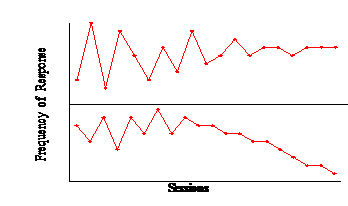
Although the results may seem compelling, one cannot conclude cause and effect by simply following a baseline condition with an intervention (an AB design, see Figure 1.8). For example, let us say we were monitoring the number of pages a child was reading before going to bed at night. First we would try to establish consistency by putting the child to bed at the same time, keeping the length of reading sessions constant, etc. After the number of pages read each night stabilized we might introduce our planned intervention, perhaps giving “stars” for every 3 pages completed. Even if the number of pages read started to increase dramatically, it would not at this time be possible to conclude the stars made the difference. Although perhaps unlikely, it is logically possible to suggest that something else coincidentally occurred at the time the stars were introduced. Perhaps the book(s) became more interesting, or the weather changed, or the child started drinking orange juice, etc.
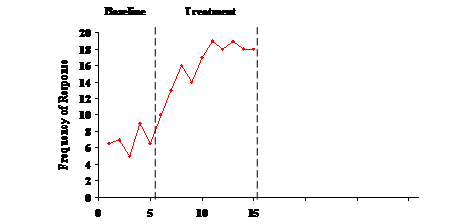
Reversal Designs
Reversal designs (sometimes referred to as ABA, see Figure 1.9) are powerful and popular small-N procedures. In our example, once the intervention results stabilized or continued to increase for several sessions, we could discontinue providing stars. If the number of pages completed then decreased, it would be possible to conclude it was the stars that made the difference. It strains the limits of credulity to suggest that a second coincidence having the opposite effect occurred at precisely this time.
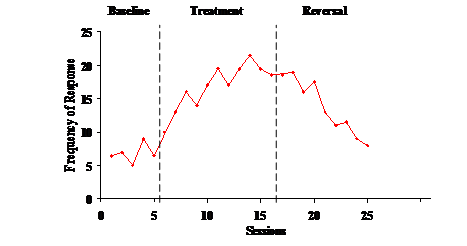
Although reversal procedures are the mainstay of small-N designs, there are unusual circumstances where reversals do not occur or where reversing the procedures would be unethical. For example, it is conceivable that after being given stars, the child discovered the intrinsic rewards provided by reading. In that instance, discontinuing the stars would have no effect. The intrinsic rewards would be sufficient to maintain the behavior, a phenomenon known as behavioral trapping (see Figure 1.10). You might think that this is just the result one would hope for. That may be true as one who cares about the child. However, if you are a researcher attempting to establish cause and effect, you are back to square one.
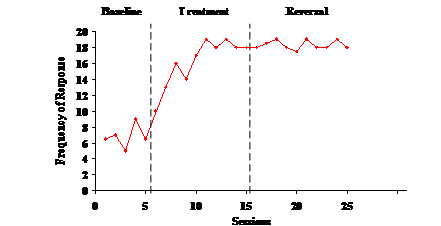
One might also question the ethics of changing a procedure that was successful in increasing a child’s reading. This concern would be more apparent in research resulting in the child’s increasing a healthy behavior (e.g., wearing seat belts) or decreasing a dangerous behavior (e.g., head-banging). Clearly, in these instances, despite the requirements of science, reversal procedures should not be implemented.
Multiple Baseline Designs
For the unusual circumstances where reversals do not occur or where reversing the procedures would be unethical, variations of multiple baseline designs have been developed (see Figure 1.11). Such designs consist of replications of AB designs across subjects, situations, or behaviors. For example, Tom, Dick, and Mary might be given stars for reading. Stable baselines would be established for each child and the treatment would be introduced at different times for the three children. Instead of working with 3 different children, a similar procedure could be implemented at home at bedtime, at home with the baby sitter, and at school. The third option would be to provide stars for reading, writing, and doing math problems. In all 3 instances, if improvement occurred during the intervention phase for all 3 children, situations, or behaviors, it would be concluded that the stars were responsible.
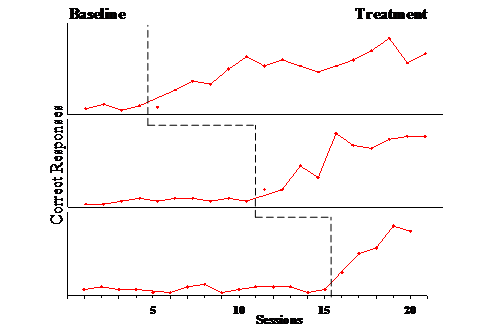
This concludes our discussion of the major experimental methods used to study psychology. If you become a psychology major you will be exposed to other, more complicated procedures in undergraduate and graduate research methods courses.
Exercise
Psychology Research Methods and External Validity
The title of this textbook assumes that our current understanding of psychology informs us about the human condition including our potential as individuals and a species. This assumption is made despite the fact that some of the research findings were obtained with other animals in apparatuses developed for the laboratory. Humans share many characteristics and needs with other animals as we all do our best to adapt to our environmental circumstances. None of us had a choice about where or when we were born, or about the conditions under which we would have to survive and, hopefully, thrive. We all need to adapt to the circumstances we experience as individuals in the journey of life.
Non-Humans as Subjects
The nature of the psychological process under investigation dictates the minimal requirements of an appropriate subject. For example, in order to study perception we not only need a subject capable of sensing and perceiving the environment (see Chapter 3), but also one able to demonstrate that it perceives. The researcher must be able to observe an appropriate response to a specific stimulus. Does this mean that other, less complex animals can be used to study processes applicable to the human being? This is actually an empirical question. One could demonstrate a lawful relationship in a very simple animal (e.g., an earth worm) and test whether the same relationship could be replicated with human subjects.
This issue is similar to the doubts expressed by many at the beginning of the 20th century that vivisection of other animals could tell us anything about human biology or inform surgical technique. In fact, many of the advances in our understanding of human physiology and surgical technique occurring since then would have been impossible if such research had not been conducted. As we shall see, there is much compelling evidence that the same is true with respect to psychology.
Besides being relatively inexpensive to obtain and house, other animals do not raise the same internal validity issues intrinsic to human subjects. That is, they are closer to the perfect spheres we could use to replicate Galileo’s findings with rocks. As we saw previously, we explain differences in behavior as resulting from the interaction between hereditary and environmental variables. Laboratory animals can be purchased from the same litter, thereby having the same genes. They can even be bred or modified for specific characteristics making them ideal for specialized research projects. For example, a colleague of mine studies the learning process in rats infected with the HIV virus (Vigorito, LaShomb, & Chang, 2007). Naturally, for ethical reasons this is a study which could not be conducted with humans despite having important implications and possible beneficial applications. Laboratory animals are often obtained soon after birth and housed under restricted conditions. Obviously, they do not have the extreme cultural and other experiential histories of humans. Also, they are extremely reliable subjects. They do not require phone reminders the previous night in order to show up for a study.
The American Psychological Association has very strict ethical guidelines for the care and use of animal subjects in research. The United States government requires that an Institutional Animal Care and Use Committee be responsible for insuring that all requirements regarding feeding, access to water, climate control, and access to veterinary care are met. One learning textbook author has quipped, “It is unfortunate that there are no similar federal regulations guaranteeing adequate food, a warm place to live, and health care for the human members of our society” (Mazur, 2006, p. 13).
Often choice of species for a research subject is a matter of convenience, expense, and tradition regarding a particular topic area. Laboratory rats are frequently favored for these reasons in addition to the fact that so much is known about their characteristics based upon their research use in other disciplines (e.g., biology). Sometimes, choice of subject is dictated by species characteristics related to a particular area of interest. For example, rabbits have an extra eyelid (nictitating membrane) making them especially suitable subjects for studying the predictive learning of eyeblinks. Pigeons have exceptional eyesight in comparison to rats and are therefore favored as subjects when investigating visual perception.
Experimental Apparatus
The choice of experimental apparatus often hinges on the same issues as the choice of subject; convenience, expense, and tradition. The apparatus must permit observation of a response related to the topic area (e.g., function of part of the brain, perception of a particular stimulus, motivation, learning, etc.). Research apparatuses are considerably different from the natural environments of the species being investigated (see Figure 1.12). It is an empirical question as to whether research findings obtained under these controlled conditions apply elsewhere for these species, let alone tell us anything about the human condition. As we review the empirical findings of the psychology research literature we must constantly remind ourselves of this question.

Figure 1.12 Apparatus to study learning.
All sciences must address both internal and external validity. This is especially challenging in psychology. We do not have the equivalent of perfect spheres as subjects of investigation. Rats, pigeons, chimpanzees, or people often differ from each other in significant ways. The behaviors we study may be complex and difficult to measure. The subjects and laboratory environments we use to obtain control over possible confounding variables are typically very different from the subjects or conditions of real interest. Psychologists are left with two difficult strategies to simultaneously address internal and external validity. They can try to capture the essence of the natural environment and recreate it under more controlled laboratory conditions. The other strategy is to attempt to introduce precise manipulation of the independent variable and measurement of the dependent variable in the natural environment. Throughout this book you will see many examples of the ingenuity of research psychologists in empirically investigating important issues while addressing internal and external validity concerns.
Exercise
use of a descriptive label for a behavior as its explanation (e.g., saying someone hits another person because he/she is aggressive)
debate regarding the importance of genetic as opposed to experiential factors as causes of behavior
observable and measurable
strategy for determining cause and effect in nature when the limitations of observability, testability, and replicability are met
the ability to draw cause-and-effect conclusions from research findings
the ability to apply cause-and-effect conclusions under naturalistic conditions
potential causal variable manipulated in an experiment
behavioral variable potentially affected by the independent variable in a psychology experiment
research method in which an independent variable is manipulated in order to determine an effect on a specific dependent variable
non-controlled variables in an experiment which could impact upon the dependent variable (e.g., wind could affect the time it takes for objects to fall)
non-experimental method measuring the degree of relationship between two variables (e.g., comparing how many ounces of coffee people drink with how many hours they sleep)
procedure whereby an individual subject is equally likely to be exposed to any of the experimental conditions
experimental procedure in which different values of an independent variable are presented (e.g., presenting different magnitudes of a reward or presenting it after different delays, etc.)
experimental procedure involving systematic manipulation of an independent variable with ongoing measurement of behavior
the first phase of a small-N design in which performance is assessed prior to the manipulation of an independent variable
A small-N design in which a baseline phase is followed by an intervention and then a return to the baseline procedures
A phenomenon whereby naturally existing reinforcers are sufficient to maintain a behavior. For example, after receiving stars for reading a child continues reading just for the pleasure.
small-N design consisting of a baseline followed by an intervention phase repeated at different times across different subjects, situations, or behaviors

